It’s well after dark when I arrive in Cortegana, Spain, a hill town in Andalucía. My host, Ana, has graciously consented to my post-9 PM arrival and has some dinner ready for me in her cozy row house.
[NOTE: To enlarge any image, right click it and choose “Open image in New Tab” or similar.
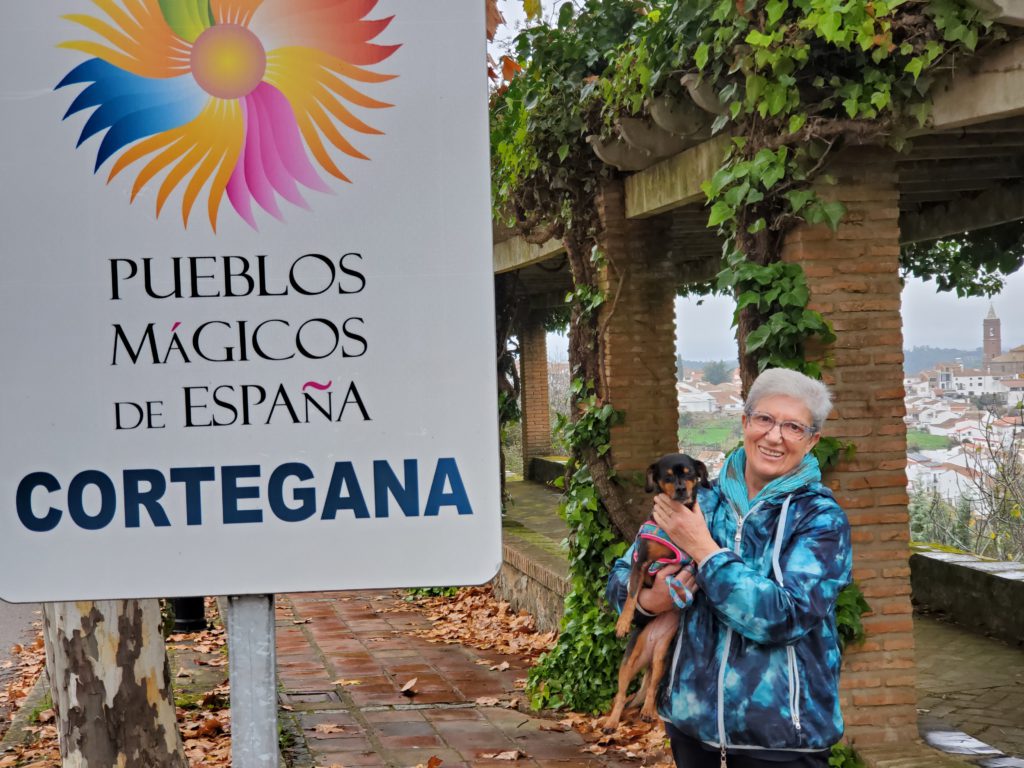
Rather than heat the whole place, she keeps a butane-fueled heater running under the small, round living room table at which we’re eating. It takes a little while for me to get used to the open flame within inches of my pants leg, but the wafting heat feels good in the winter chill.

One of her dogs takes an immediate shine to me (and I think to every visitor) which is always fun for a pet-lover-but-no-longer-owner like me.

After eating and chatting for an hour or so, Ana heads for bed and I go to sleep on the living room couch.
In the morning, I’m drafted as assistant dog walker for her 3 dogs. Alone, she has to take them out in two shifts but with me there we can take them all at once.
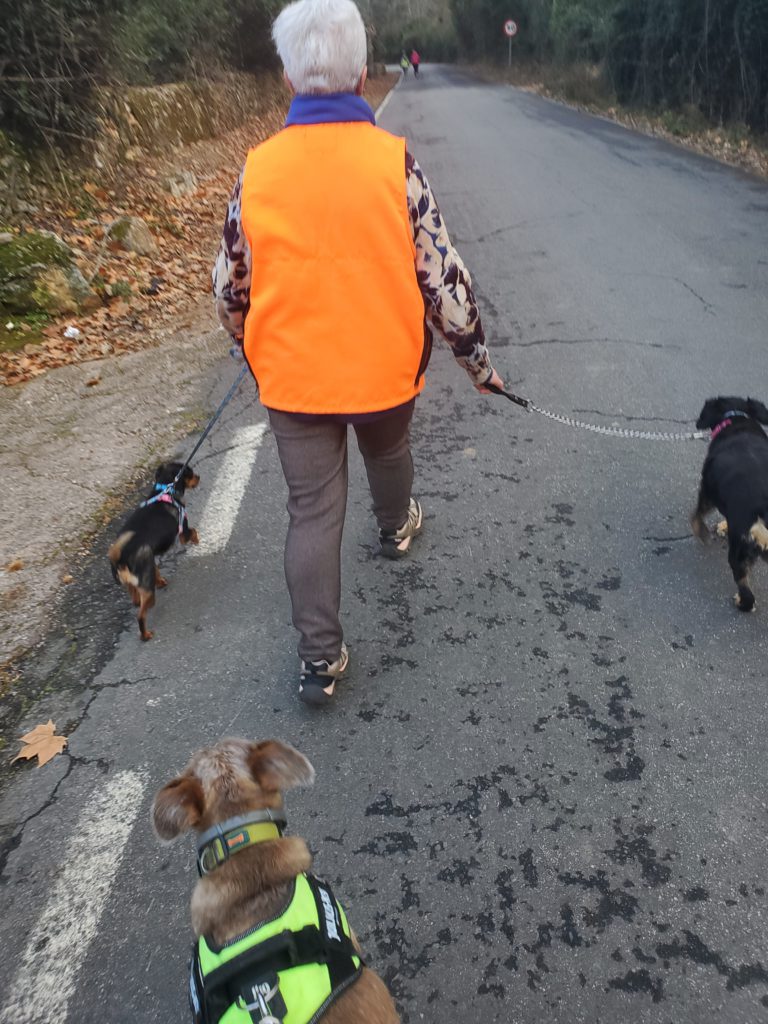
The walking route goes along a ridgetop road with beautiful views of the castle on the hill opposite.
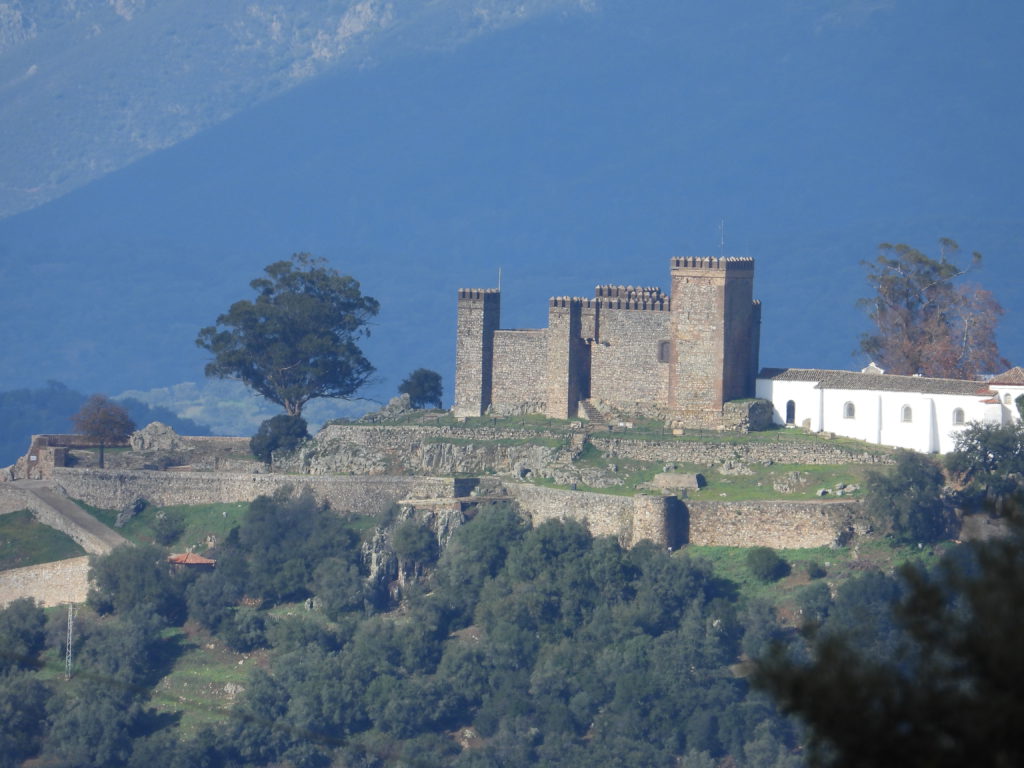
The dog obligations fulfilled, Ana takes me on a walking tour of the town. She’s lived here all her life, taught thousands of students over decades, and knows everyone. She volunteers at the Red Cross and other organizations, so our progress by foot is frequently paused with greetings and exchange of news. About every third person is a former student. It feels like I’m accompanying a politician greeting her constituents.
Although, amazingly, I don’t remember when it happened, one of my pairs of blue jeans has a severe abrasion rip and brown discoloration, to the point where they’re no longer serviceable. Perhaps someone borrowed them while I was sleeping [grin]. Realistically, it must have happened 3 weeks ago in the national park where I lost and recovered my phone and I’m only now noticing. Ana takes me to a clothing store — where they know her, of course — and helps me get a good deal on a new pair. It’s much easier than trying to navigate the process in Spanish on my own.
We stop at the town cultural center, beautifully tiled and with a community cafe, then on to the Red Cross office where grocery bags are being packed for distribution to the needy.
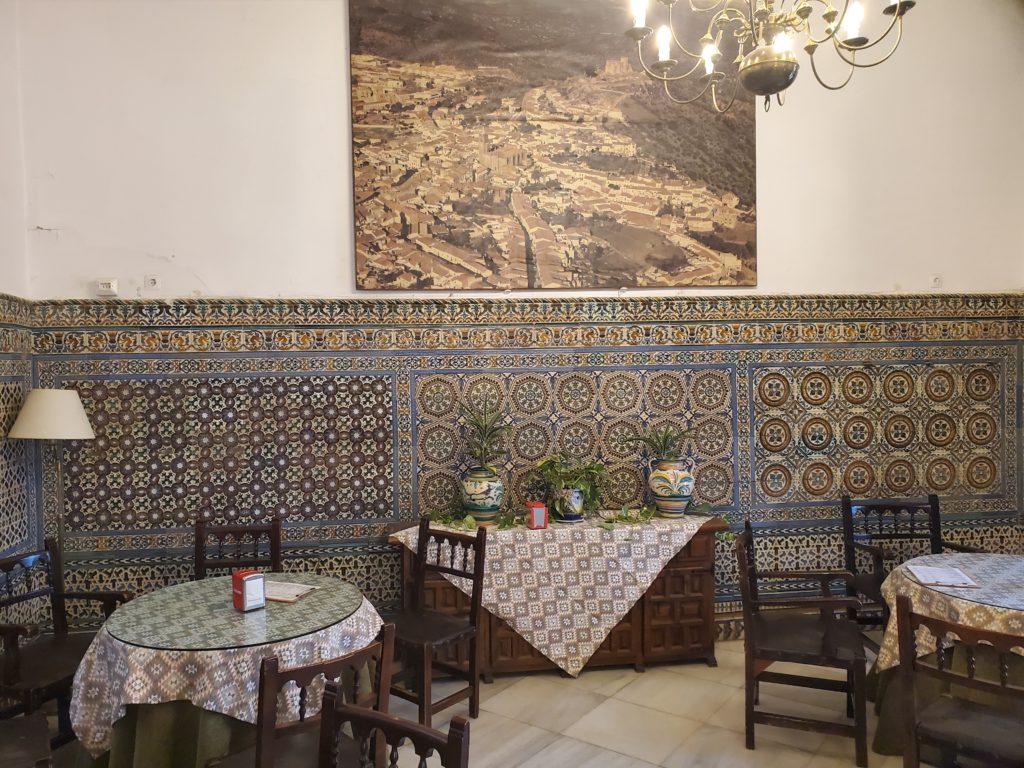
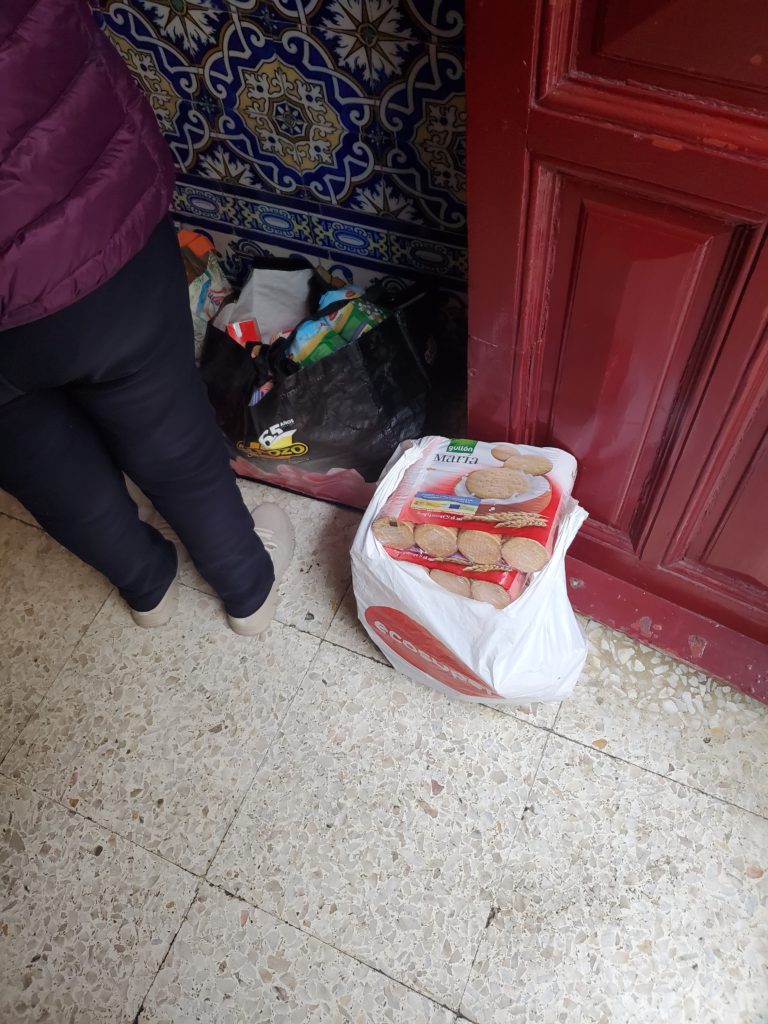
Cortegana is a hill town, with many steep streets, stairways, and fortified houses built to withstand attacks by unfriendly visitors — presumably not a modern day problem.
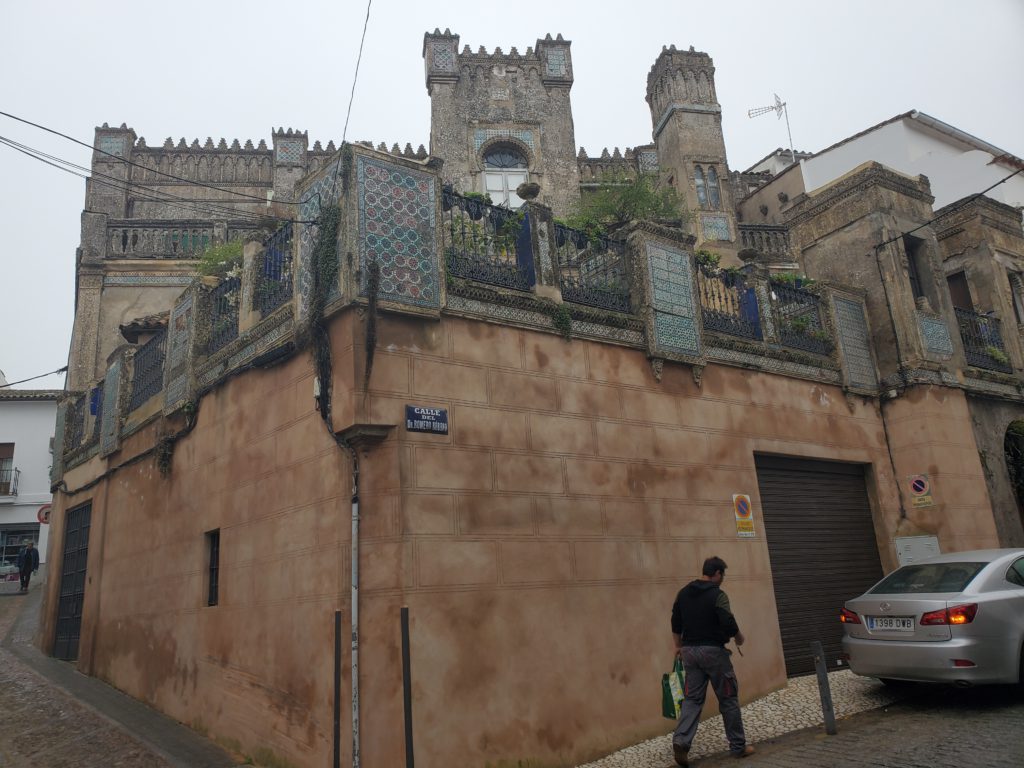
Interestingly, many buildings have a tile mosaic on the sidewalk representing the trade carried on inside: clockmaker, magistrate, etc.
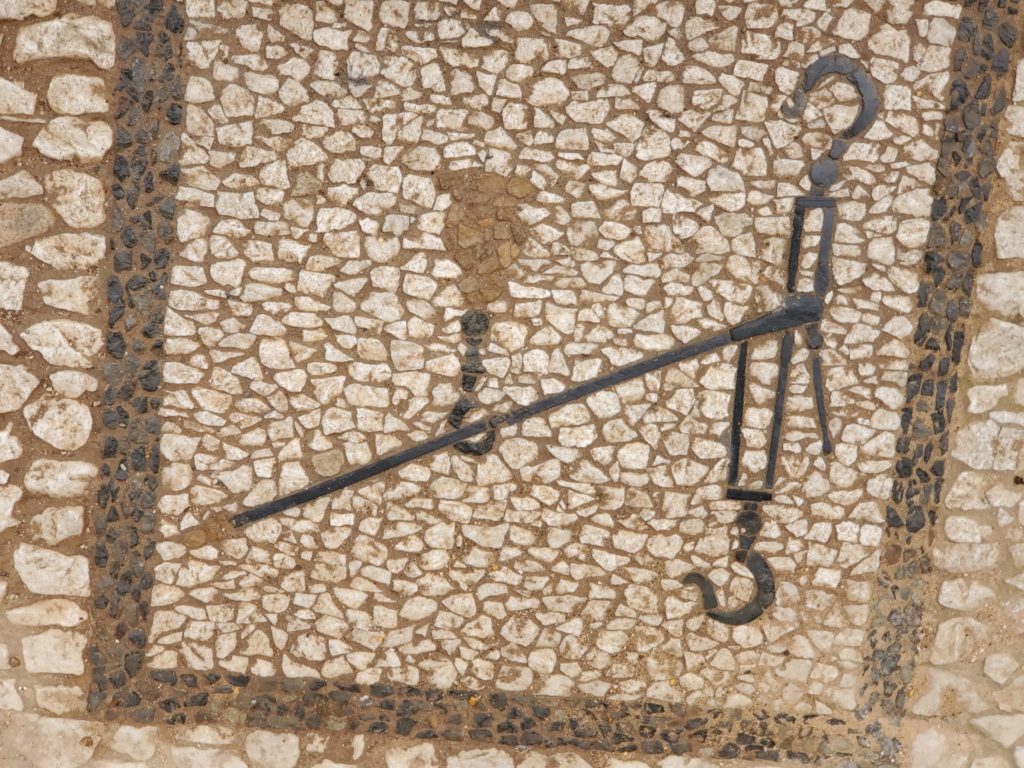

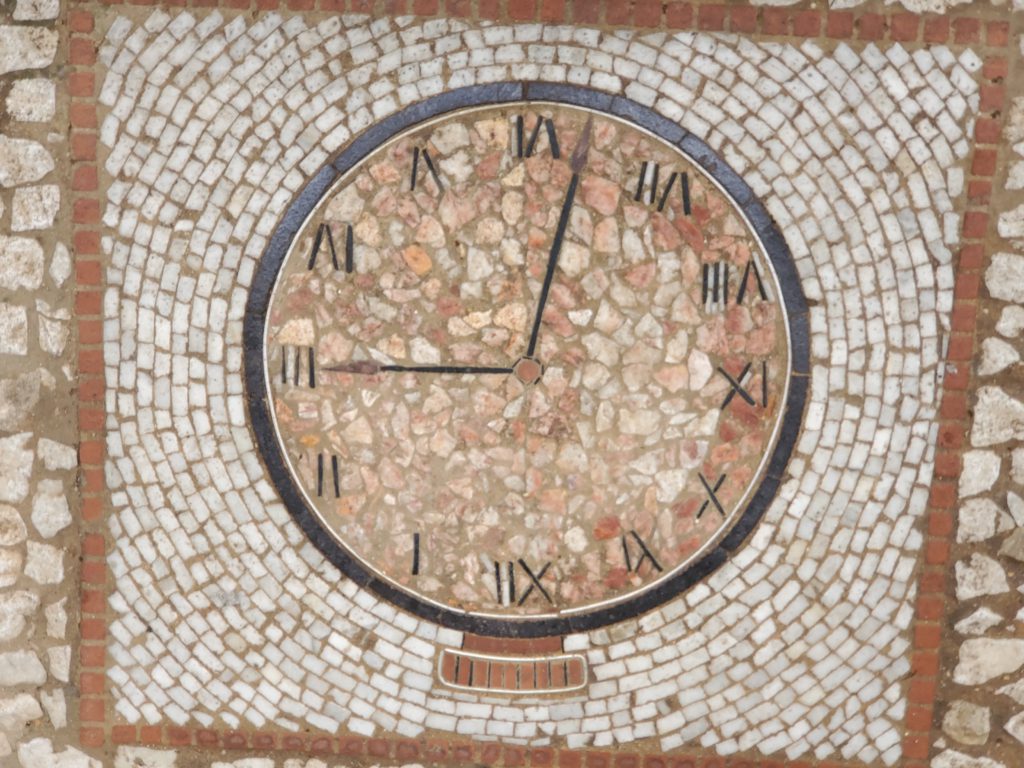

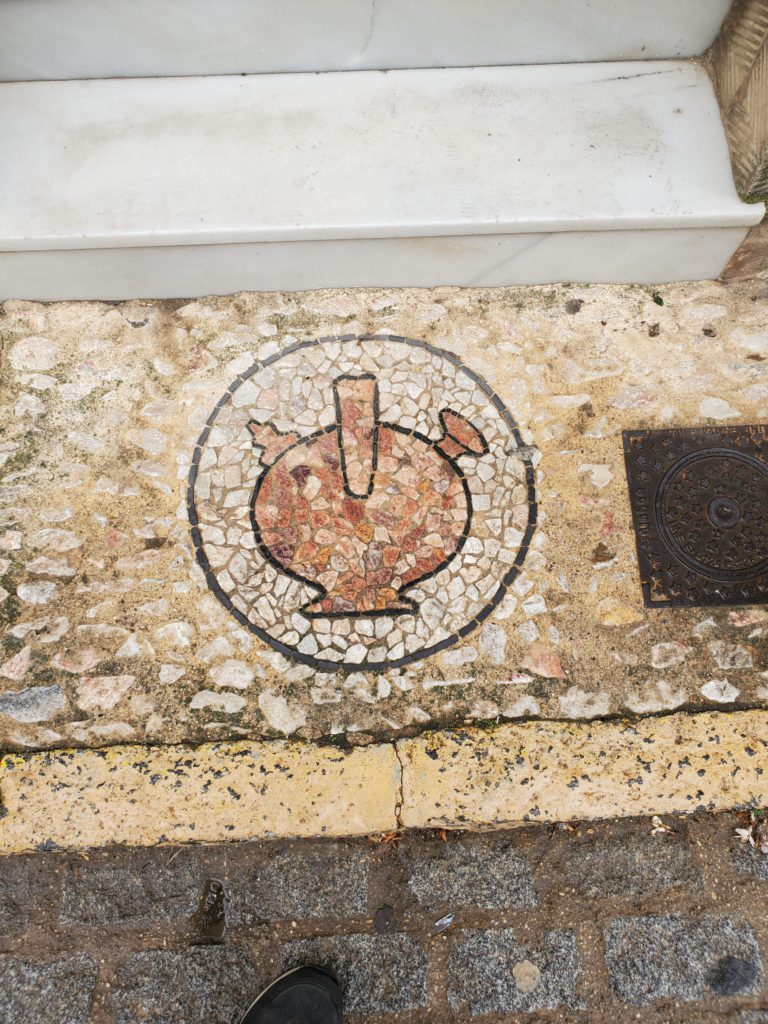
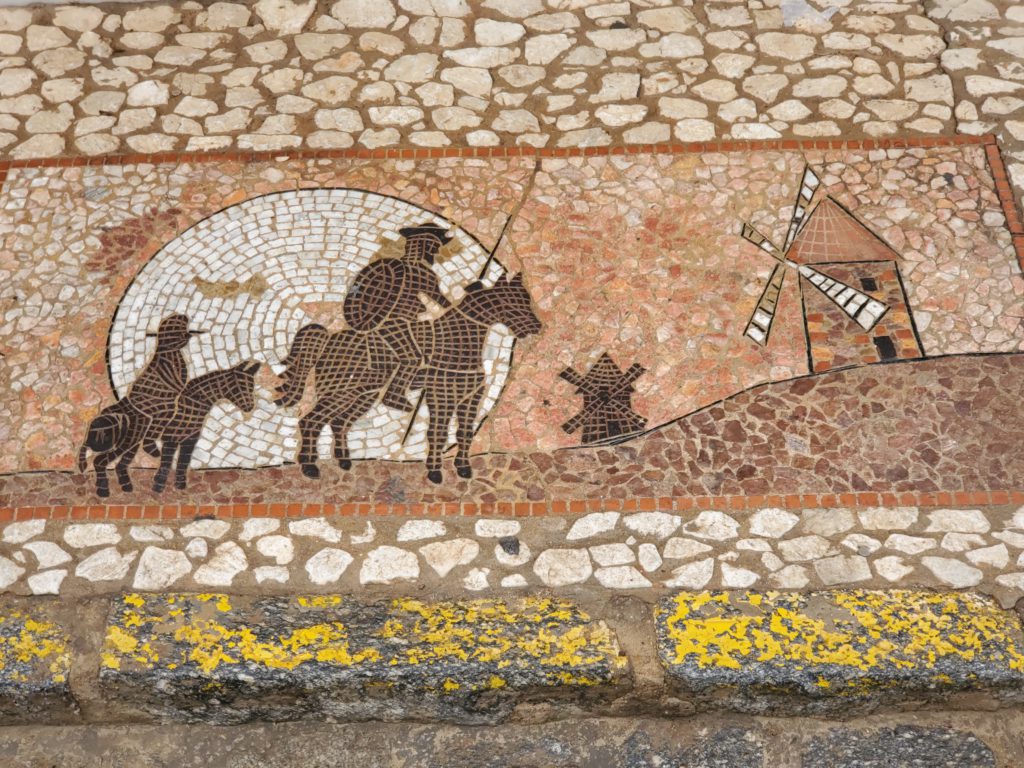
Although many Spaniards now find it cruel and distasteful, bullfighting is still widespread and Cortegana has an active plaza de toros (bullring) and a large sculpture honoring at least one slaughtered bull.
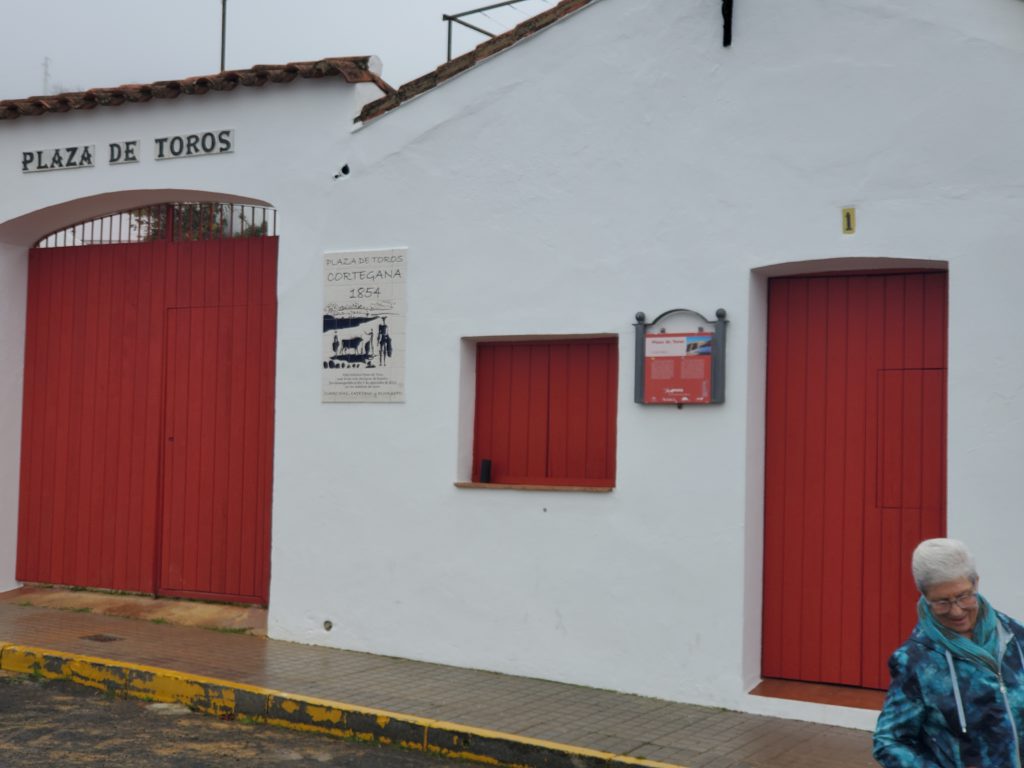
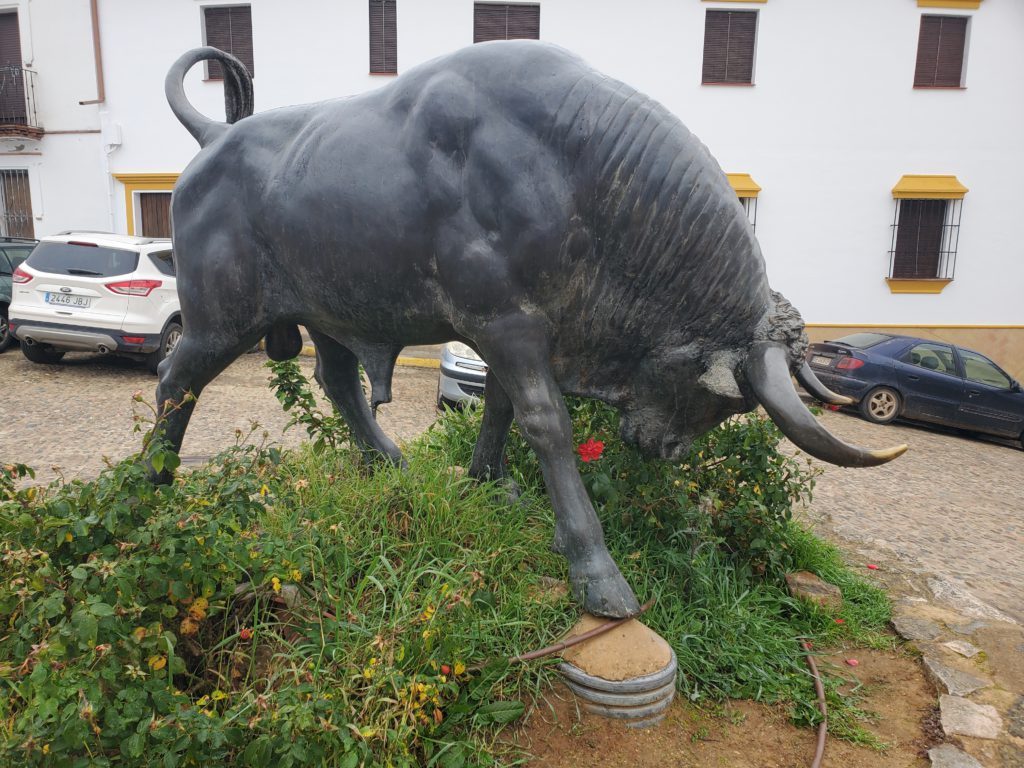
Late in the evening, Spanish style, Ana cooks a great fish dinner and a variety of roasted vegetables — eaten of course with the heater flaming at our knees under the table.
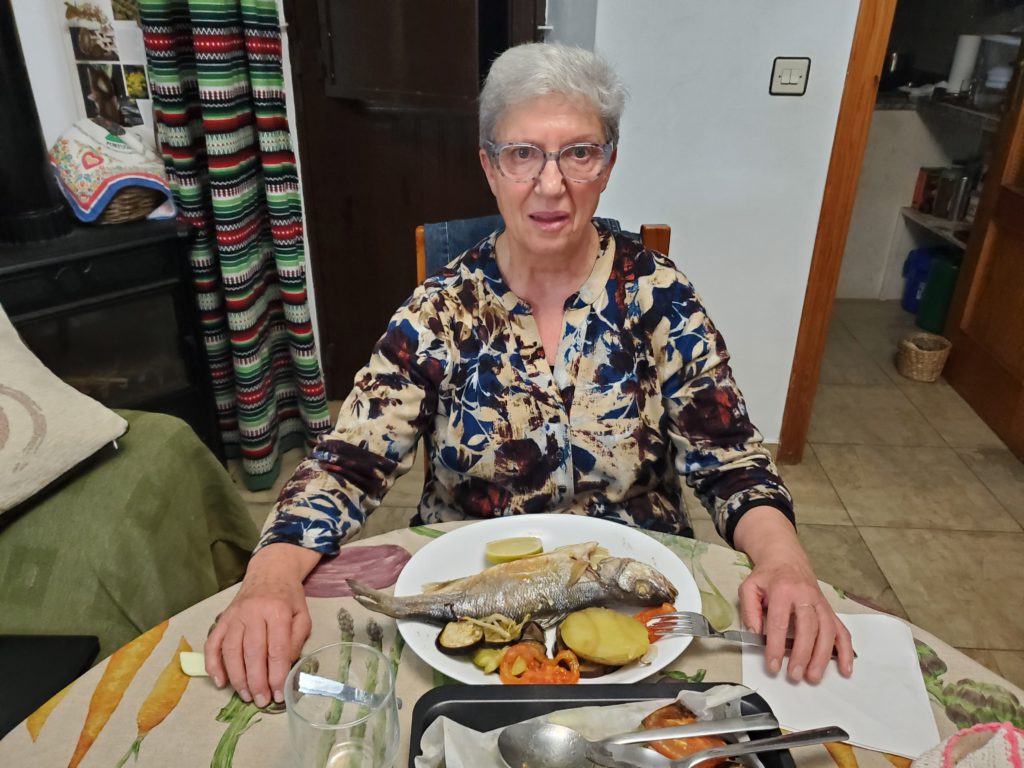
Wednesday, after the morning dog walk, Ana and I go to neighboring Almonaster la Real, home to a 9th century Islamic mosque and fortress high above the village.
On the narrow footpath up the hill Ana has us stop at a group of several low buildings which turn out to be a private museum built and operated by Carlos, one of her former students, and his father, They have spent years rebuilding and furnishing abandoned animal housing into several interesting, traditional, themed rooms: a doctor’s office, a bar, and others. This ongoing project is truly a labor of love, supported only by hard work of two men and the donations made by visitors. Carlos is always on the lookout for additional historical items to acquire. He and his father are continually renovating the next building. Without these efforts much of the material and context of bygone years would be lost. He calls his museum Exposición El Buscador de Setas (Mushroom Hunter’s Exposition).
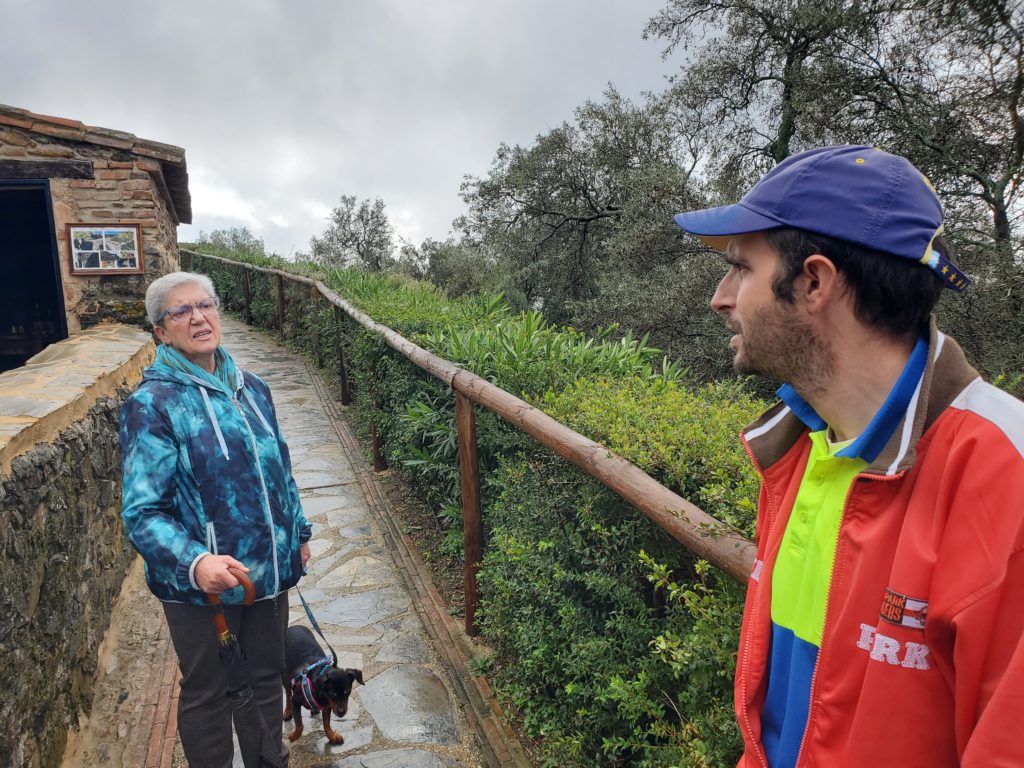

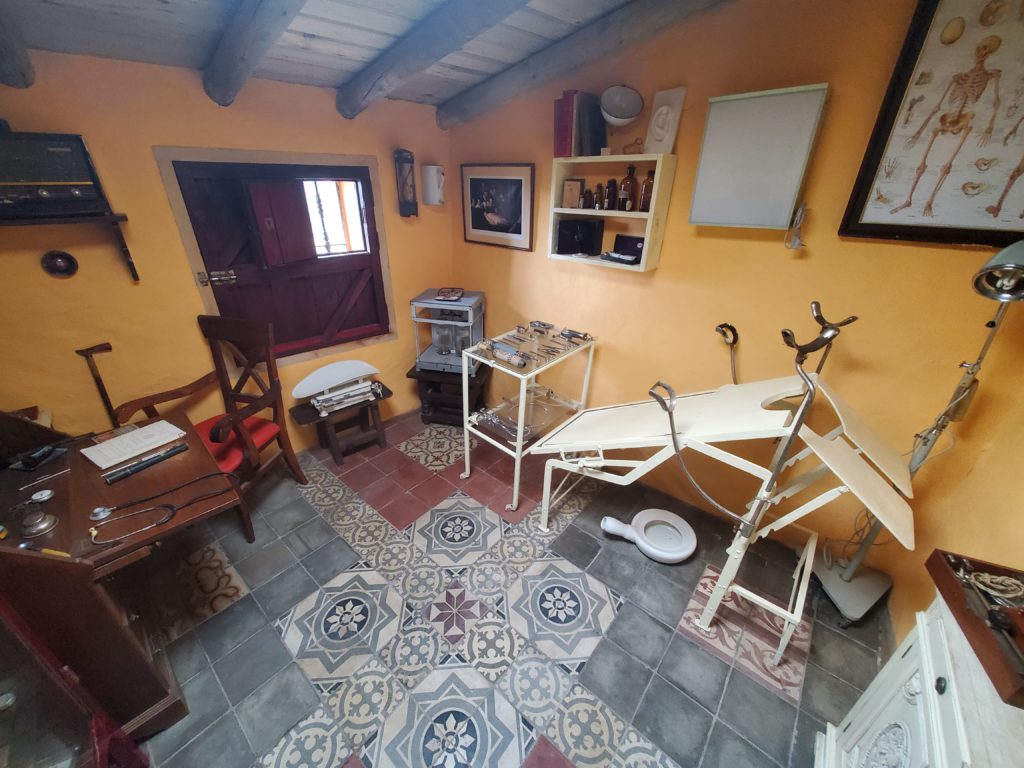
The 10th-century mosque and fortress were built during the Moslem rule of Iberia using the stones of a pre-6th century Roman and Visigoth fort and temple. For those not familiar with the term, Iberia, it refers to the Iberian Peninsula, comprised of modern day Spain, Portugal, and tiny British Gibraltar, Although there were Christian modifications made after the Moors were expelled, much of the mosque character was preserved. This is a rarity since many Moorish buildings were destroyed or rebuilt after the Arabic conquerors were defeated and expelled by 1492. Moslem names still persist widely, though. Any Iberian name that starts with “al” (the definite article “the” in Arabic) is very likely from the Moorish era. A well known example is the Alhambra in Granada, Spain.

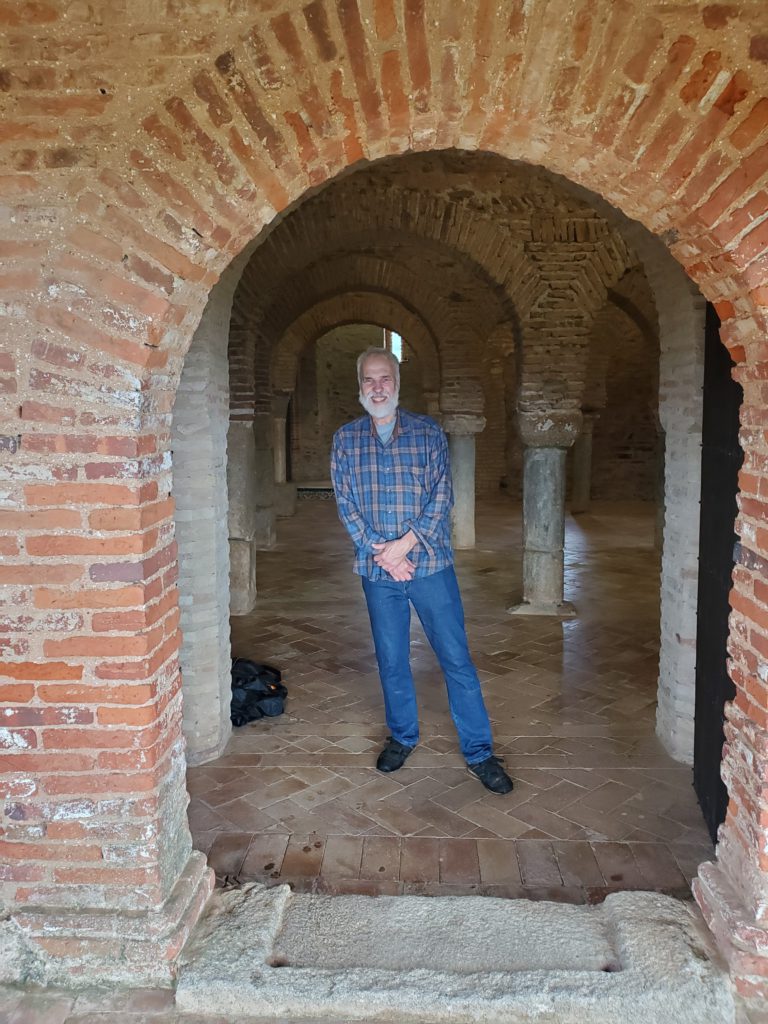
Back in the car, I detour slightly to a small road I saw on the map. Twisting our way up the narrow, steep route, we end up at the top of an adjacent mountain, Cerro San Cristóbal with panoramic views of the surrounding towns and valleys, including the fortress we just left. As is typical, the summit has a prominent communication tower that blocks the view from certain vantage points, but it’s easy to ignore the disturbance.

I bring Ana back home, say goodbye, and leave Cortegana for the fairly short drive to Sevilla, the major city in Andalucía. I’ve been invited at the last minute by a Servas host in the suburb of Palomares del Río. I arrive in the afternoon and meet another Ana, this one a very personable public radio newscaster in another city, Córdoba. She has a 16 year-old daughter, Sabina, and they are hosting 16-year old Delilah, an exchange student from Manhattan. The man of the house is Pola, who I assume to be Ana’s husband or long term partner. Later in the evening, he tells me he has been dating Ana and has only moved into the house in the last month or two. I’m surprised because he really seems to fit into the family very naturally. I would not have guessed.
I’m used to Servas hosts being older and retired. This visit is a bit different because Pola (a television news producer) and Ana both work pretty long hours in addition to their various family duties. About 40 minutes after my arrival, Pola and Ana are driving into Sevilla to see a movie produced by one of their friends, so we have only a short time to get initially acquainted.
I have an appointment (explained below) at 9 PM, so I decide to ride in with them and spend the evening sightseeing the city. When they drop me off, I start by walking through the pedestrian zone of the old town. It is lined, like many old towns, with stores selling absurdly high price merchandise. Who are these tourists that walk around a town buying enough $5,000 watches and handbags to keep 20 stores in business? Incongruously, along this strip is a very attractive tile mosaic reproducing a Studebaker automobile ad. Looking it up, I find it dates back to 1924.

A little further along, I see a long line in the street — at least 100 people. As I seek the head of the line, I see everyone is waiting to buy lottery tickets. It’s a perfect example of “hope dies last” since virtually every purchaser is guaranteed to lose their money.
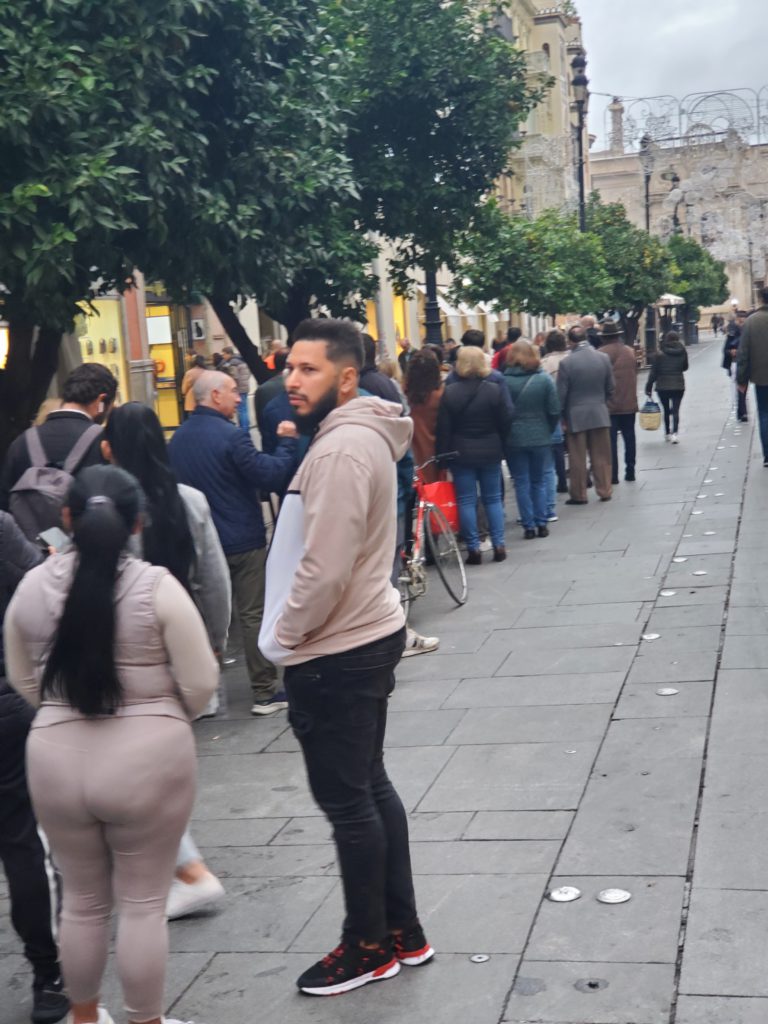
Leaving the pedestrian zone, I approach the obligatory cathedral with a freakishly enormous extended kiosk selling figurines and other religious items.
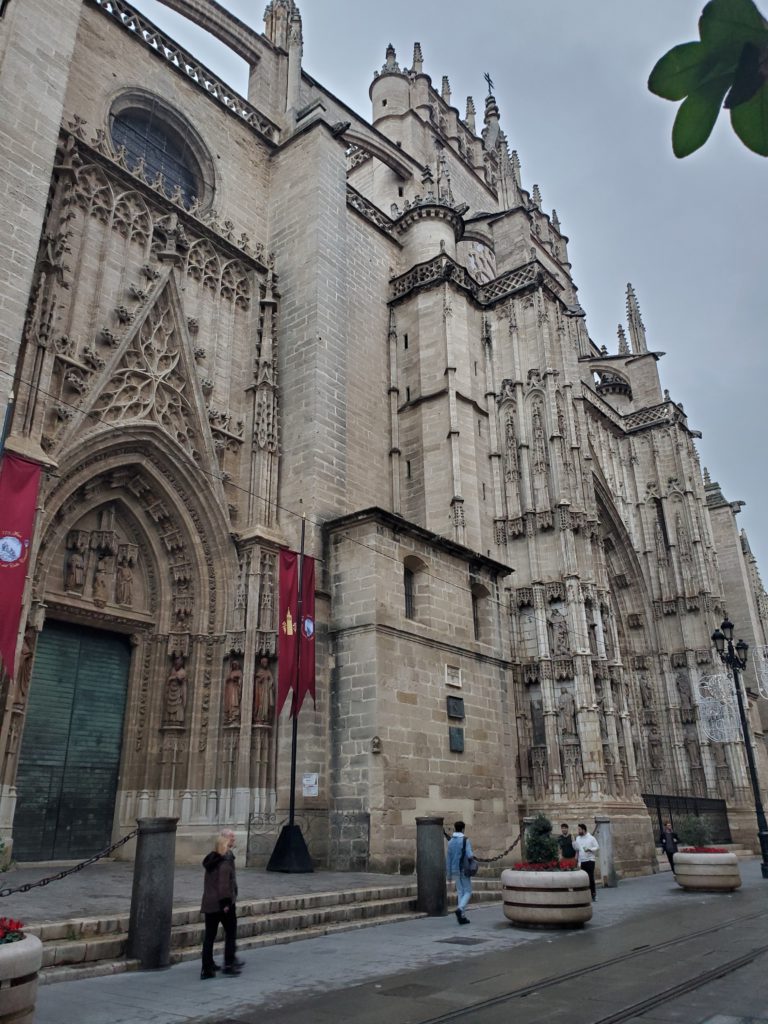
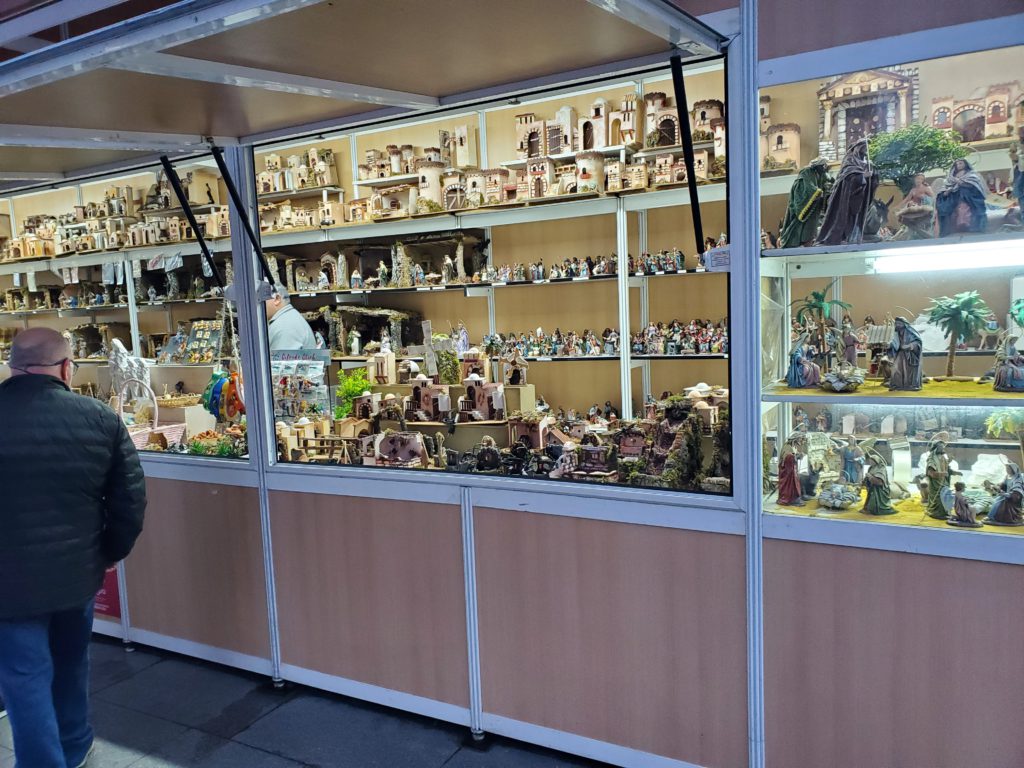
I next find myself on a campus of city and university buildings. I soon realize the majority of them were built as pavilions of the Ibero-American Exposition of 1929, Most have the original country names engraved into the entrance along with a smaller sign indicating the building’s current use.
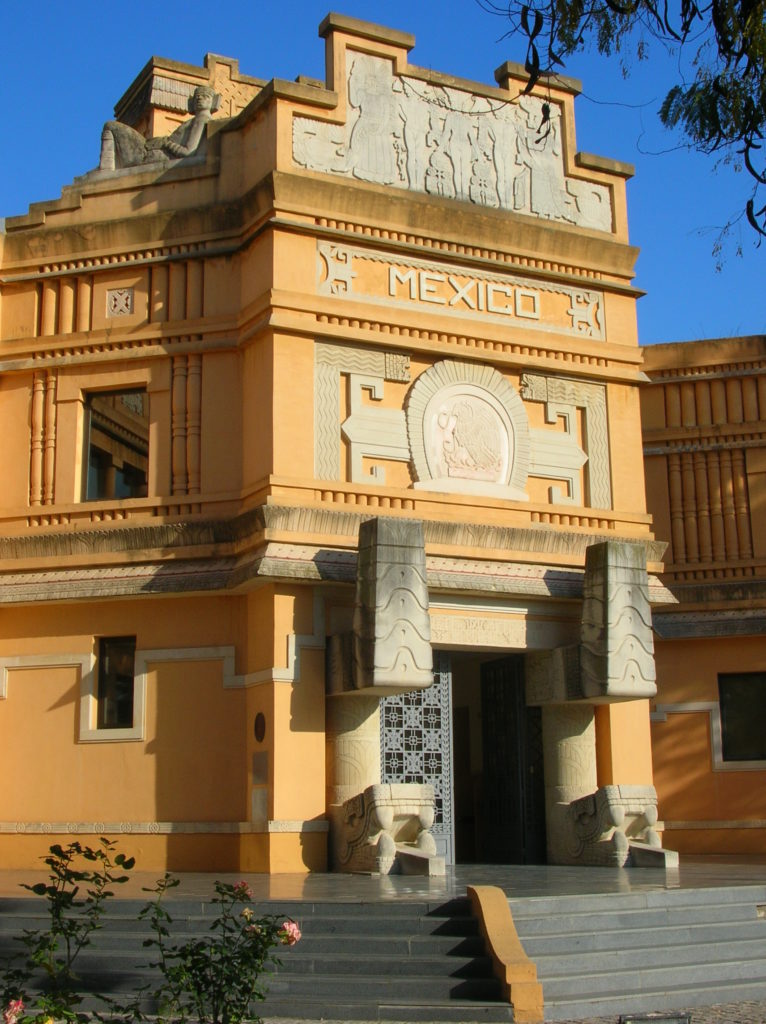

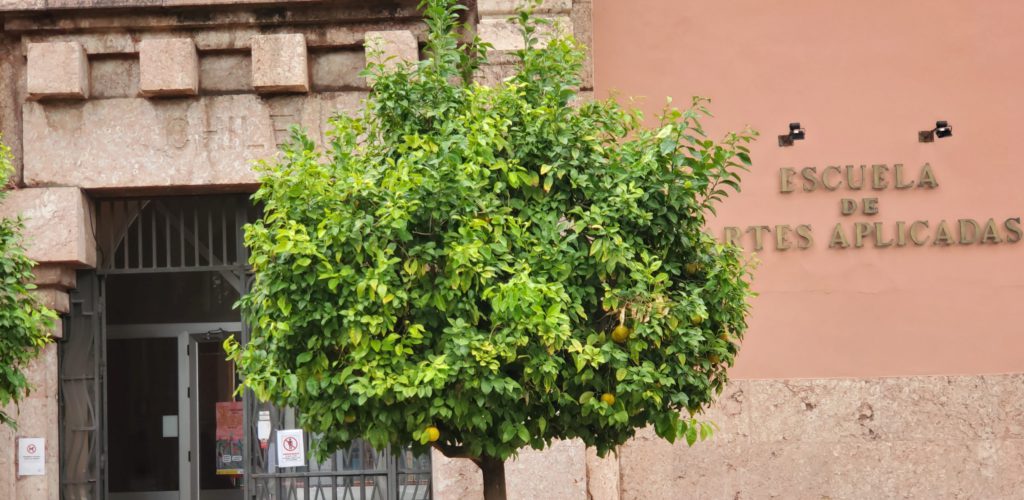
Continuing on, I reach the former exposition’s centerpiece, the Plaza de España. It’s a giant semicircular building originally housing all the Spain exhibits and now repurposed for various government agencies. It’s an ornate structure designed to evoke several historical architectural styles. Inside the semicircle is a D-shaped moat with paddleboats for rent. A very popular place.
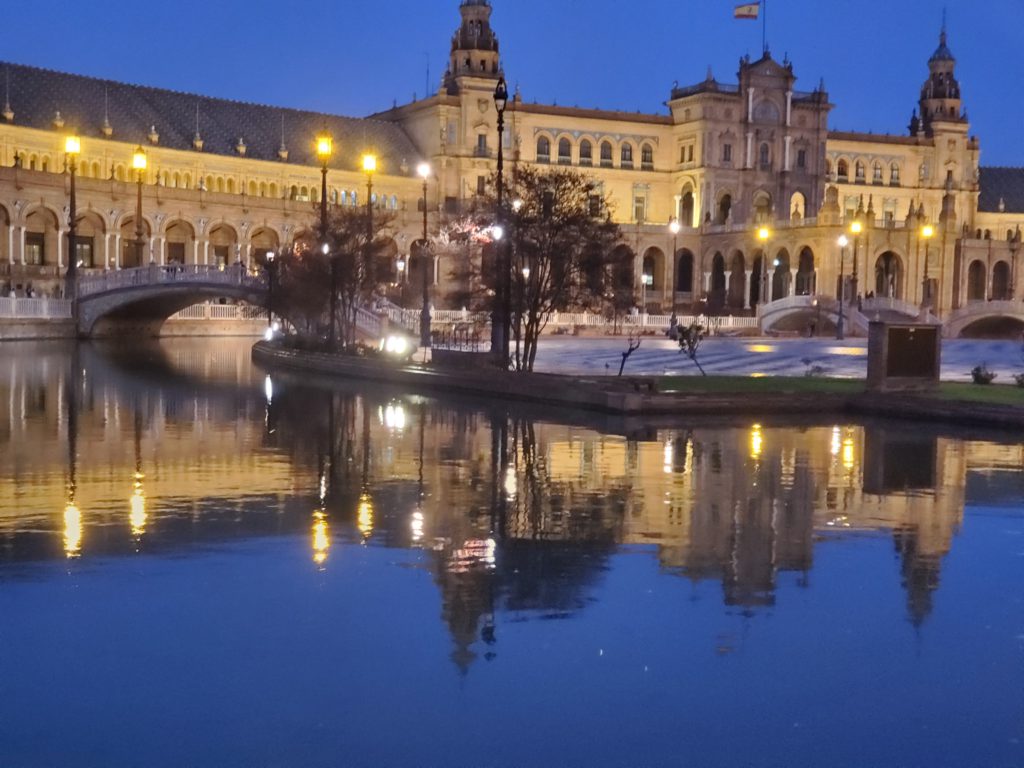

Leaving the plaza, I walk through dark Maria Luisa Park, also built for the exposition, until I cross the old course of the Guadalquivir River, turned into a dead end canal 100 years ago to mitigate navigation and flooding problems.
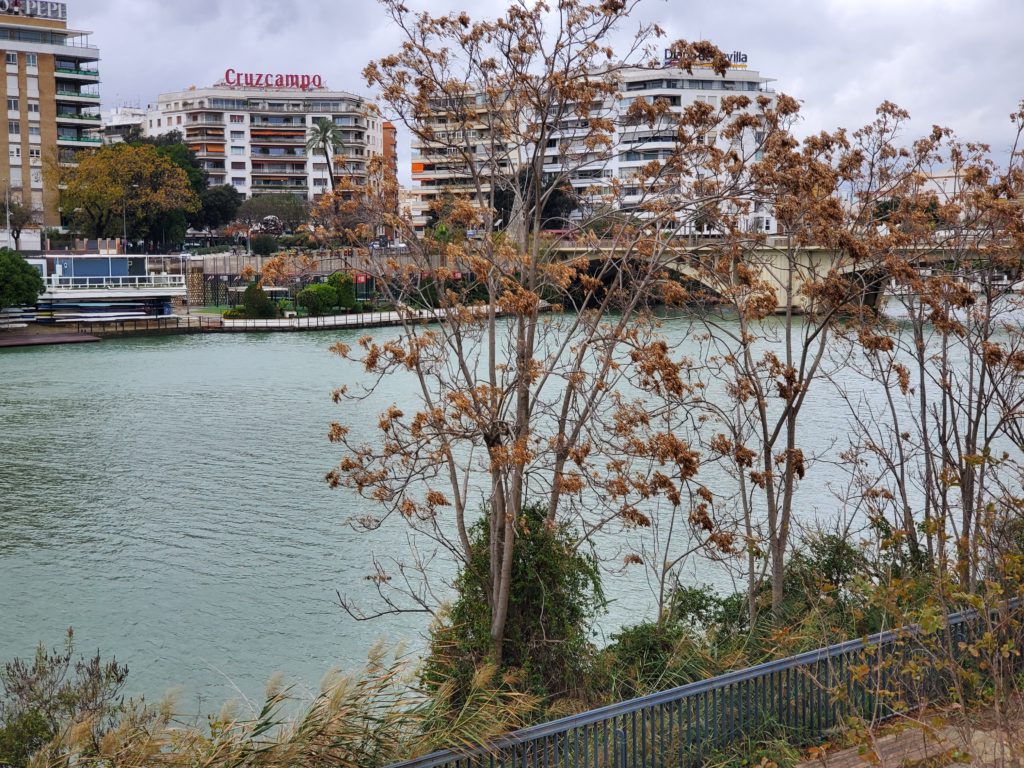
My destination is a restaurant where a Servas host who is also a private detective and author, Juan-Carlos Arias, is debuting his new book, whose title translates as “Franco’s Forger”, the story of Eduardo Olaya, a talented art copyist who could paint apparently authentic masterpieces on demand.
Although Juan-Carlos cannot host me this week, he did invite me to the event. I’m ever so slightly a special guest because, by sheer coincidence, Susan has a second hand connection with one of the book’s prominent characters, New York art dealer and publisher, Stanley Moss.
I arrive at the restaurant early, trying to recognize Juan-Carlos when he walks in. While waiting, I order some tapas for dinner — by sight because none of them are labeled. The food is quite good but one of the items turns out to be sangre frita, fried blood. Edible, but not something I would order a second time,

As the 9 PM meeting time arrives, a number of patrons are avidly watching football (soccer). The restaurant isn’t looking like a particularly apt venue for a book discussion. Finally, I ask someone who looks the part if they are Juan-Carlos and the owner, who is also watching the game, chimes in that the meeting has just been moved to a nearby bookstore — because of the football telecast. Spaniards have clear priorities.
At the bookstore, I find Juan-Carlos, his wife, and about 3 fans — a disappointing turnout for sure, but good for me as I’ll have a reasonable chance of following the conversation of the other participants. I comprehend quite well when someone speaks Spanish directly to me, but it’s frustrating that I generally can’t understand two Spaniards speaking to each other in colloquial speed and enunciation. The discussion runs about an hour, with me trying desperately and only partially successfully to follow the content.

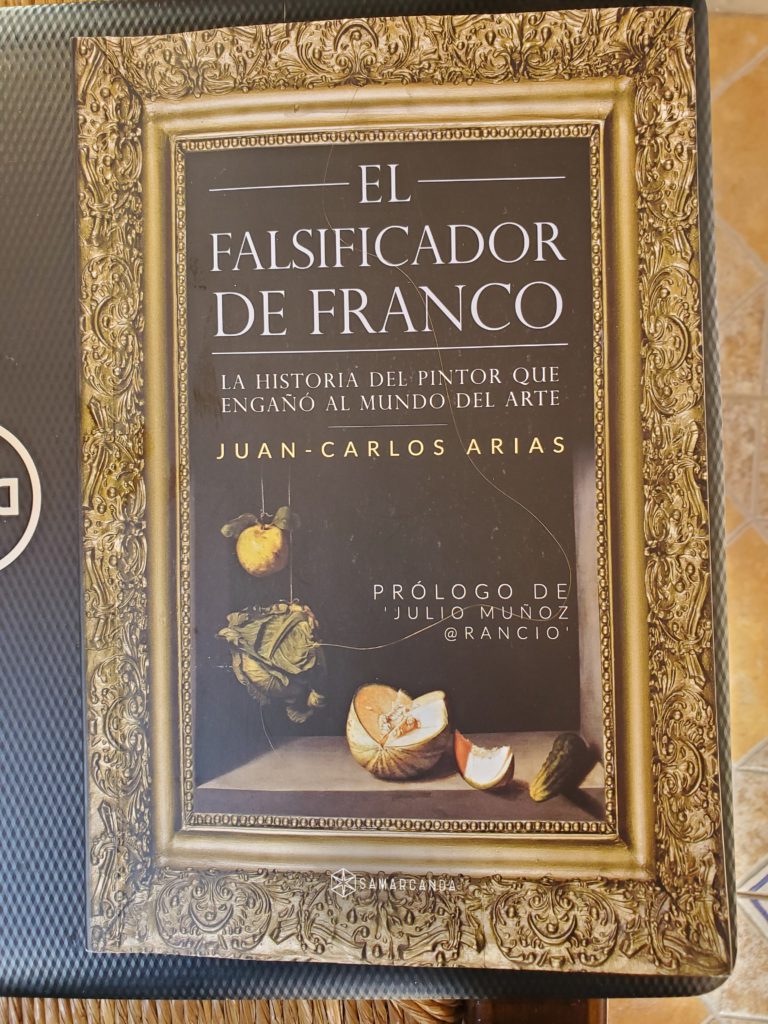

As the meeting breaks up, Juan-Carlos inscribes a gift copy of his book to me and Susan. He, his wife, and I agree to walk to a nearby bar for coffee. He’s an interesting guy, a real old time character. I look forward to getting to know him better on a future visit. As we leave the bar, I navigate to a bus stop and ride out to Ana’s house. The $1.50 fare is paid in cash but the drivers don’t accept bills larger than 5 Euros, which are all I have. A kindly passenger pays my fare.
I don’t get home until 10 PM but the evening meal in Spain is also quite late. Ana serves a quick dinner over which we spend some time talking, but it’s a work/school night, so everyone is in bed shortly thereafter.
Thursday, everyone is off to work and school in the morning but I get a late start and catch the bus into Sevilla around noon, heading for the House of Science museum. It’s very well done, with exhibitions addressing sustainable development, cetaceans, geology, an extensive explanation of crystals and their properties and uses, and Gaia, the European Space Agency’s star mapping satellite. I thoroughly enjoy my time there.

I decide to attend a flamenco dance show, of which there are several in Sevilla, all tourist-oriented of course. I choose the one that seems most serious, walk over and buy a ticket for the 5 PM show.
On the way, in every direction is Sevilla’s impressive architecture, for example, the Palacio de San Telmo. Built in 1682 by the Catholic Church’s “department” in charge of the Spanish Inquisition, I suspect its splendid architecture masks a sordid history. It was designed as a new facility of the University of Navigators and dedicated to training orphans as sailors. There must have been quite an excess of orphans to merit such an institution. Sailing was very hazardous work and sailors very expendable. The school was founded while the highly anti-Semitic and anti-Muslim punishments and executions run by the same people were still in progress. Executions, orphans, danger, sailors… Hmmm.
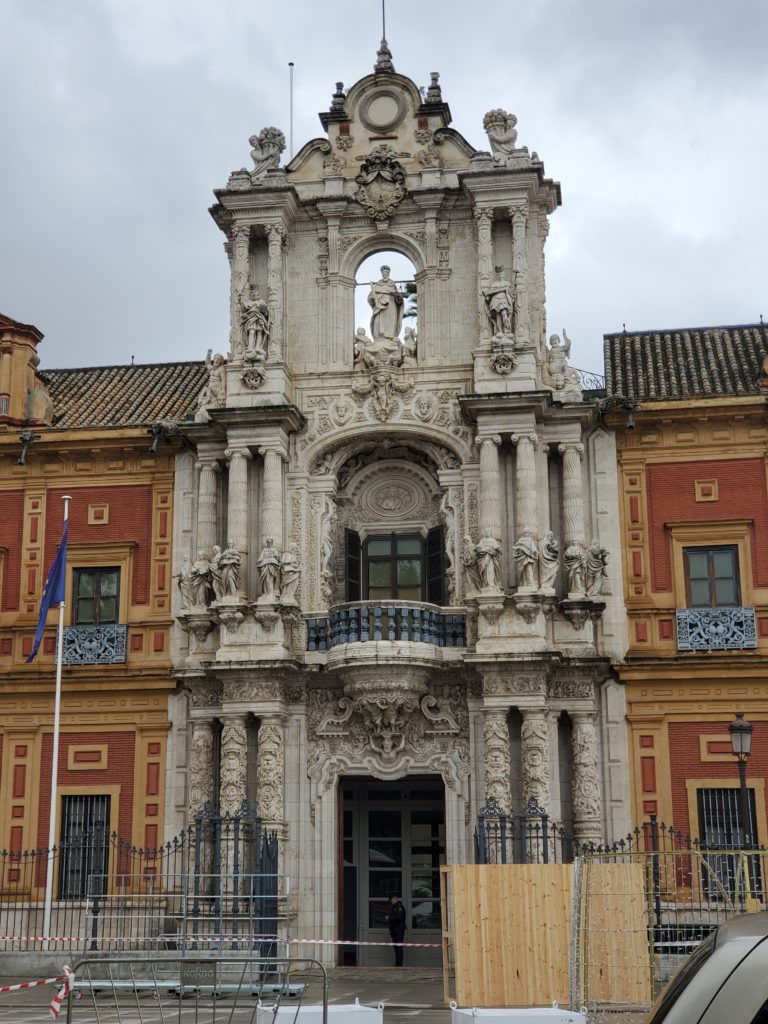
I cut through a small park, Cristina’s Garden and find an unheralded and unexpected poet’s walk. Every 100 feet or so is a tablet-like stone engraved with a verse from some well-known Spanish language poet.

Show ticket in hand, I spend the intervening time going through the museum. Flamenco is a complex tradition and the museum illustrates this with mind numbing detail on vocabulary, style variations, the significance of costume details, hand movements, and more.

When the show starts, the cast is three dancers, a guitarist, and two singers, performing in a small, brick basement theater with intimate bleacher seating. I’m sitting within 3 feet of the dancers and I’ve positioned my camera in my lap pointing at where I believe the primary action will be. I’m being subtle so as not to wave my bulky camera around in front of my seatmates during the show. I want to record some of it for Susan’s sake because she’s not here. When, during the pre-show announcements, a “no photos” rule is announced, I realize that I’ve prepared myself perfectly for this unexpected development. I’m not recording for any purpose other than Susan’s virtual attendance and a short illustration in this blog (trust me, read by very few people), so I don’t feel my violation is doing any harm. Throughout the hour long show, I video various dance numbers, although I have to settle for whatever framing my camera happens to capture. There’s a lot of loud foot stomping, flamenco guitar accompaniment, and singing that often sounds like painful caterwauling to me. The performers are obviously skilled and dedicated. In fact, they do only one show a night, doubtless due to the level of energy expended. The other two shows each have a completely separate company. Sadly, to my crude artistic taste it’s cultural overkill. In the future, I’ll leave the adoration of flamenco to others.
As I hit the bathroom after the show, I encounter unique Flamenco-ized privacy panels between the urinals.
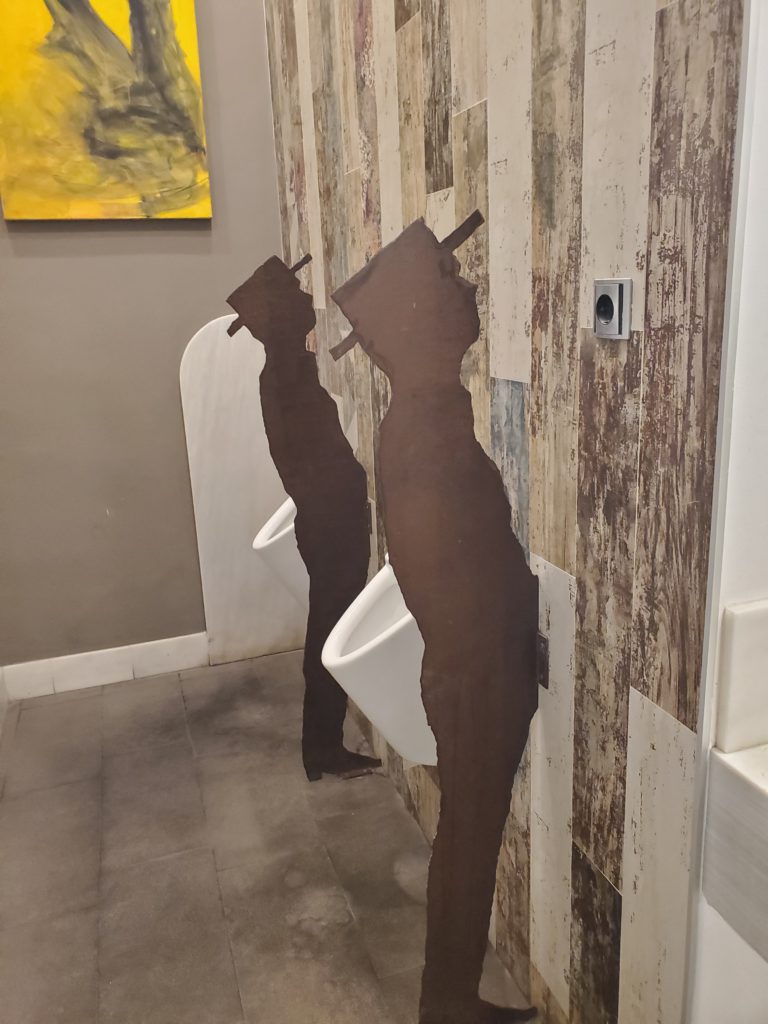
Today, I get back to Ana and family in the early evening and we have some hours of social time. I get along very well with everyone, including the teenagers, and it’s turning out to be an excellent, if time-limited visit. Ana does her news broadcast from home once a week, so she doesn’t have to commute by train to Córdoba every day. She appears to be one of those superwomen, doing a demanding job, domestic work, and parenting. We stay up quite late, talking about work, radio, politics, and family.

Friday morning, it’s time for me to leave. Ana and Pola are going away for the weekend. Despite our fun visit, they don’t invite me to stay longer, probably for the implicit but very sensible reason that you don’t leave a man you’ve just met home alone with two teenage girls. I certainly wouldn’t have done that when Helene and Eric were young.
Since I want a couple of down days to do some work and writing, I check into a hostel on the other side of Sevilla. It’s super cheap, unheated, and situated at the end of a long dirt road, even though the surrounding neighborhoods are quite urban. It has spacious grounds and a sort of shabby, rural feel to it, yet I find it quite comfortable and pleasant. Even if it weren’t, the nightly charge is so low that, as the Jewish yentas in Brooklyn used to say, “For that price, you could hate it.”
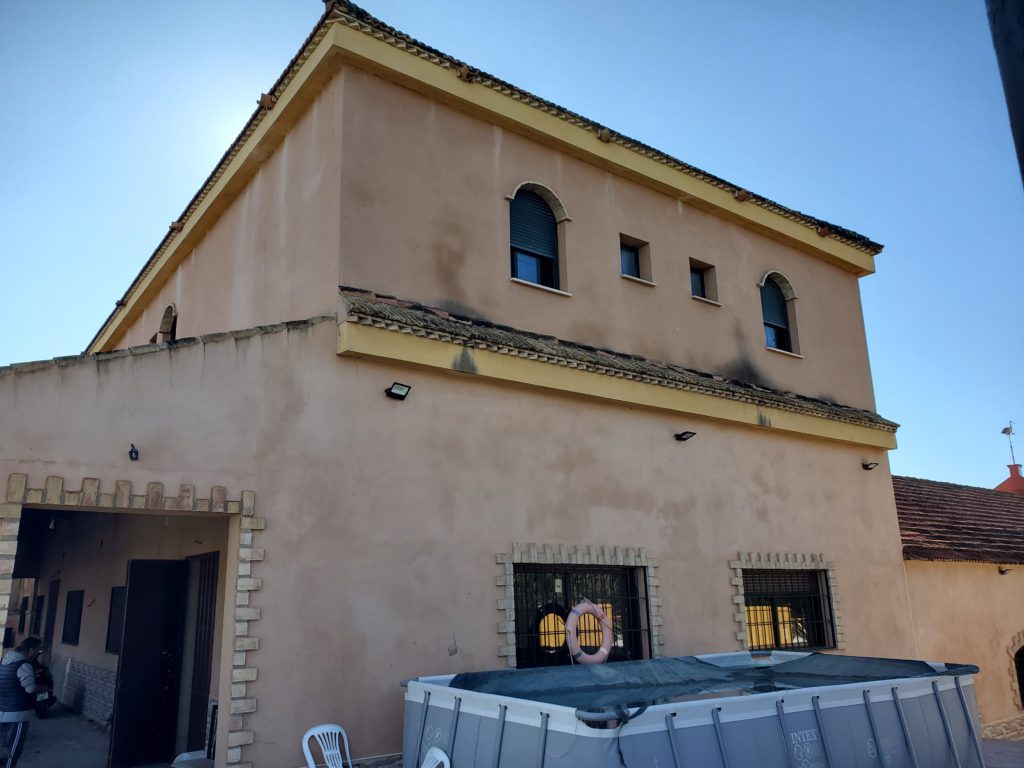
Saturday, at a supermarket, I find fresh rainbow trout at a giveaway price, so I buy two large fish and cook an elaborate dinner in the hostel kitchen.
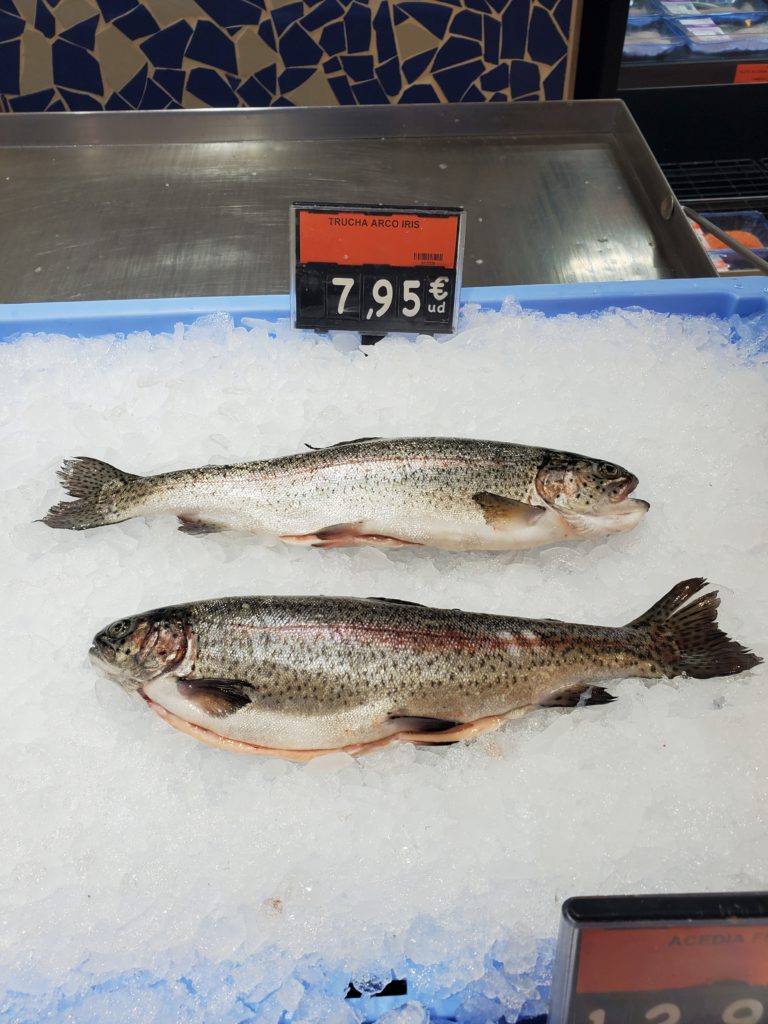
I’m now making a firm plan for taking the ferry to Morocco and decide on Sunday morning I want the car checked over for hidden problems prior to making the crossing. I text Ana, who is back home, and ask whether she can refer me to a repair shop that she trusts. She gives me the name of a national chain she uses and also invites me to come back for a second stay.
Since everything in Spain is closed on Sunday, I spend the remainder of the day at Ana’s house. There’s finally time for some real socializing. In the afternoon, the three of us go around the corner to a very convivial bar devoted to a regional Catholic “thing”, the Peña Rociera. It appears to relate to an annual procession in an Andalucian town named El Rocio but despite extensive online research, as usual, I can’t comprehend what it is or its significance. Given my enormous respect [sarcasm] for the Catholic Church, it really doesn’t matter to me. The interior of the bar is decorated with dozens of farm implements and historical photos in addition to Peña Rociera memorabilia.
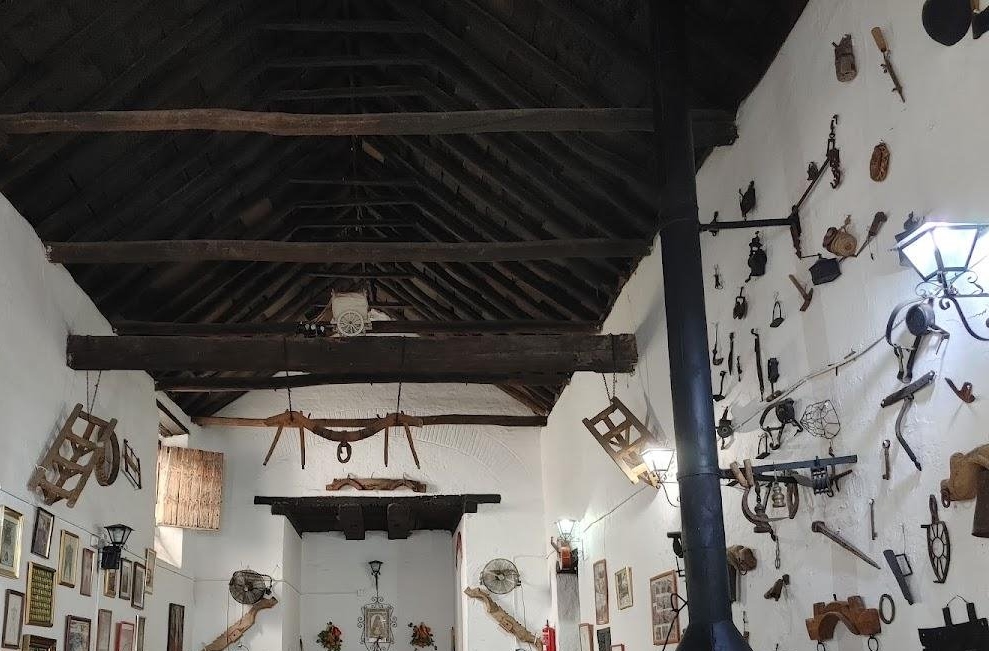
We encounter a friend of Ana’s who buys us a round of beer, which leads to reciprocal rounds. The bar has a special supply of fresh must, a preliminary wine phase. I’d like to try it but after 4 beers, I’m done. In the U.S., four beers is about half my annual consumption. Back at home, Ana and Pola cook a great dinner while I plan my car repair strategy for tomorrow. I make an appointment for a full diagnostic first thing in the morning but I have another task as well. The ABS (brake) system failure light has come on several times. The problem goes away when I shut off the engine but it’s a warranty issue and I’ve just realized tomorrow is the final day of my 1 year warranty so I have to get to a Citroën dealer immediately to handle that. It’s going to be a busy day.
Monday morning, I’m at the repair shop before 8 AM. Their appointment email had promised “while you wait” service but in person they tell me I have to leave the car. I hop the bus back to the house but in less than 2 hours I’m notified the diagnostic is complete so it’s back to the shop. The only significant problem that turned up is a need for new front brakes. They say they can do that this evening, so in the meantime I drive over to the Citroén dealership to report the ABS symptom.
They are very friendly and diagnose the problem while I wait. It’s just a failing sensor/switch but they have to order the part so the repair can’t be completed until tomorrow. They’re also very cooperative making sure the failure is reported to the warranty company today, by the deadline.
I return home for a few more hours with the family and head back to the first repair shop for my brake appointment. The brake job and a tire rotation take over 3 hours. Since two of my tires are fairly worn and the other two also on their way, I’d like to replace them. Unfortunately, all-season winter-rated tires, which are mandated in Germany, where I’m heading after Morocco, are only available in warm, sunny Spain with a 7 day lead time. Reluctantly, I decide to travel in Africa with my existing tires, hoping my luck will carry me through for another 2 months or so. (Sneak peek: I did surprisingly well.)
Tuesday morning, I go back to Citroën for the ABS repair. We can find no way to submit the warranty claim for direct payment, so I pay the substantial bill myself knowing I will have to deal with reimbursement at a later time. Eric has warned me about the casual attitude toward customer service in Spain so I’m not expecting an easy resolution.
That task accomplished, it’s back to Ana’s for my final evening. To help out, I drive Delilah, the New York exchange student, to a friend’s house and enjoy the Christmas decoration lights along the way. I’m told downtown Sevilla has a very elaborate display, and I saw some of it being installed a few nights ago, but it’s not worth a 2 hour round trip bus ride to view it tonight.
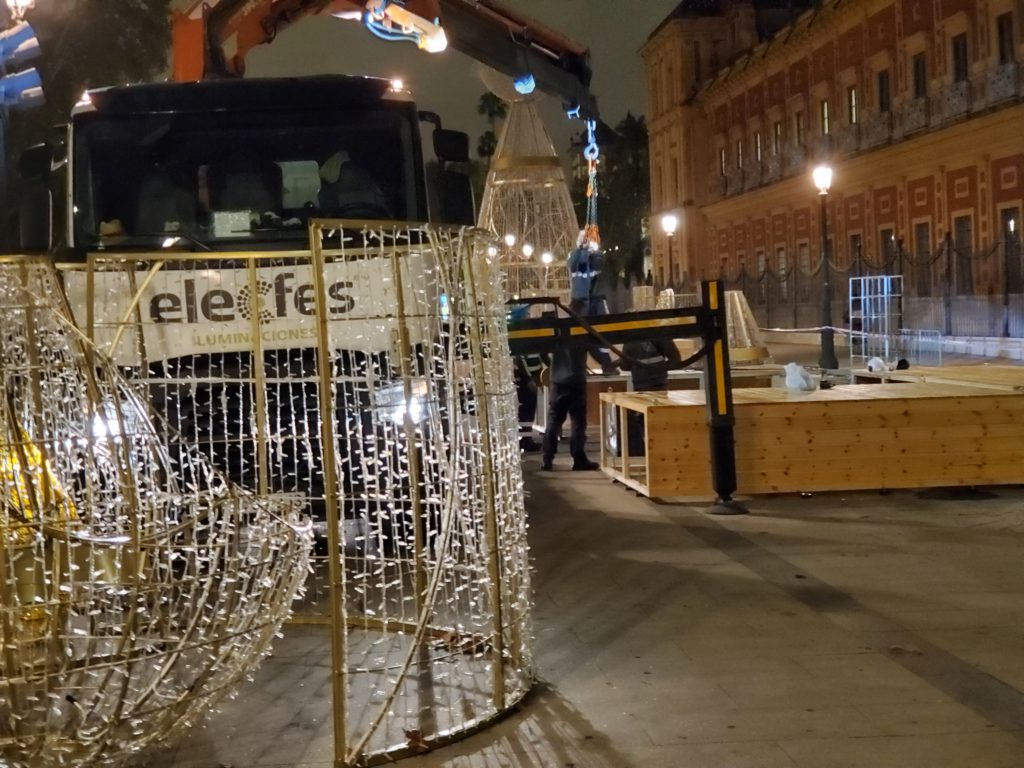

Wednesday morning, we say our goodbyes before the family heads out the door and a couple of hours later I journey south to Algeciras on the Mediterranean coast, where I’ll catch the one hour ferry across the Strait of Gibraltar to Africa.







